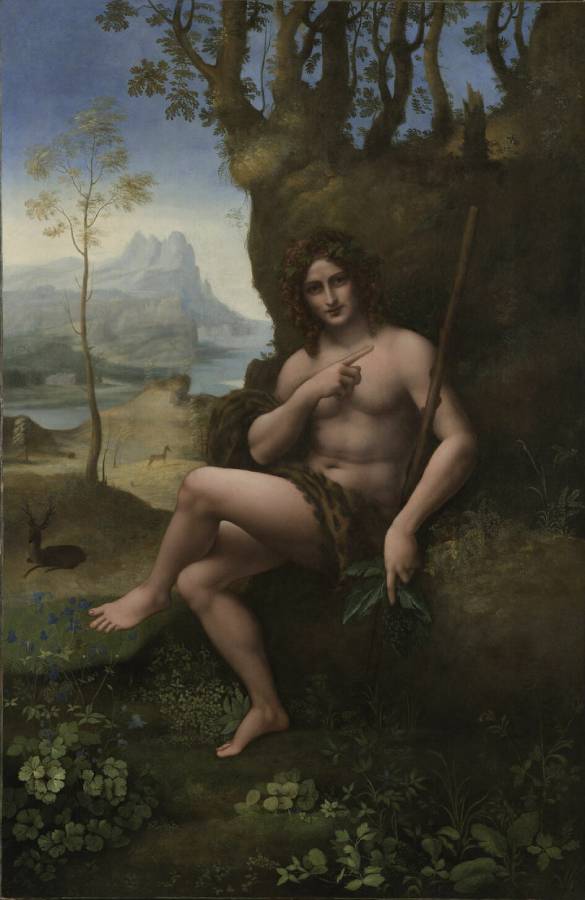Leonardo da Vinci (1452-1519) & Workshop
San Giovanni nel deserto, Bacco (St John in the Wilderness, Bacchus)
c.1517–1520
Oil on wood transferred to canvas, 177 x 115 cm
Musée du Louvre, Paris
We do not know the circumstances of the creation of this painting which is similar to Little Saint John the Baptist by Leonardo da Vinci (Paris, Louvre Museum). Its setting in a landscape makes it a more narrative composition, evoking his life as an ascetic in the desert. A red chalk drawing, formerly kept in Varese, is sometimes considered to be a preparatory sheet by Leonardo, but it should rather be considered a studio work, perhaps by Francesco Melzi. There are several other painted versions of this composition, some faithful to the current state of the image (Saint John the Baptist transformed into Bacchus), while others represent the figure of the saint. This success of the invention could suggest that Leonardo was the designer. In fact, in the inventory of the goods of his faithful student Gian Giacomo Caprotti, known as Salaì, drawn up in 1525, where copies based on the master’s creations are listed, a painting of a “great Saint John” is mentioned who could be a version of the composition. The image offers affinities with several works by Raphael and his circle (Saint John the Baptist, Florence, Galleria degli Uffizi), painted precisely during Leonardo‘s stay in Rome, between 1513 and 1516. It should also be noted that the figure of saint closely resembles one of the ignudi painted by Michelangelo on the ceiling of the Sistine Chapel (1508–1512). The recent restoration has revealed the beautiful quality of execution of the painting. Several details, such as the flowers of the meadow or the body with very defined contours, evoke the Vertumnus and Pomona signed by Giovan Francesco Melzi (Berlin, Gemäldegalerie). The work on the skin tones is, however, more subtle, with more contrasting transitions from shadow to light. One would be tempted to see it as a later work than that of Berlin, painted by Melzi for Francis I, when he was installed in France with his master from 1516. From the beginning of the 17th century, the image of the young smiling saint seems to have disturbed religious sensibilities. Cassiano dal Pozzo notes that the painting “does not inspire devotion”. This probably explains his transformation at the end of the 17th century into a pagan deity, with the addition of several attributes of Bacchus, such as the bunch of grapes in the left hand or the crown of ivy on the head and the change of the cross into a thyrsus. At the end of the 18th century, the painting was transposed from wood to canvas, then underwent a major restoration in 1827–1828. A new intervention was carried out by Cinzia Pasquali between 2017 and 2019. This intervention, as well as the scientific examinations carried out by the C2RMF, made it possible to better understand the different transformations of the image over the centuries, and above all to specify the attributes added from the 17th century. It was indeed necessary to understand whether the figure of Saint John possessed attributes specific to Bacchus from the 16th century, like the little Saint John the Baptist by Leonardo of the Louvre who wears the skin of a spotted animal and not that of a camel. In addition, several images of the Baptist, painted in Florence by followers of Leonard, such as Raphael or Andrea del Sarto, also present the saint crowned with vine leaves. During the current intervention, we could see that the spotted animal skin was original, therefore similar to the master’s version kept in the Louvre. However, the grapes and the ivy wreath were added later. Likewise, the thyrsus turns out to be a transformation of the traditional cross held by John. (Louvre)
